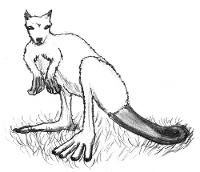Though it has the same name as genuine (albeit long extinct) creatures of the Miocene epoch, this glyptodont is so unlike its namesake that it is obviously a wholly different beast. Described as a mammal built like a great and terrible kangaroo, the glyptodont stands some sixteen hands high when lowered to a quadrupedal stance, though it more typically hops about on its hind legs or tail. In this position it is able to attack with its forepaws, striking blows so destructive that the remains of persons struck by them are not sufficient for burial.
Despite this, its tail is its main weapon, being made of a material that is elastic and springy, but tough as horn; this appendage is used as a spring with which the club-tailed glyptodont may propel itself, as a means to harmlessly absorb the force of impacts when falling from a great height as a shock absorber, and most terrifyingly, as a weapon. In its capacity as a weapon, the glyptodont uses its tail to lift boulders and hurl them by spinning and hurling the great stones as if throwing a shot, the force akin to a great cannon.

